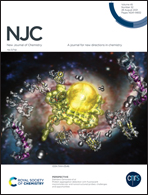A thioridazine hydrochloride electrochemical sensor based on zeolitic imidazolate framework-67-functionalized bio-mobile crystalline material-41 carbon quantum dots
Abstract
In this study, we introduced the synthesis of an innovative nanocomposite based on zeolitic imidazolate framework-67 (ZIF-67), bio-mobile crystalline material-41 (Bio-MCM-41) and carbon quantum dots (CQDs) for the fabrication of a simple, economic and novel electrochemical sensor on a glassy carbon electrode (GCE), namely, ZIF-67/Bio-MCM-41/CQD/GCE for the electrodetermination of thioridazine hydrochloride (TRZHC), for the first time. The prepared nanocomposite was characterized via relevant techniques such as scanning electron microscopy, energy-dispersive X-ray spectroscopy, X-ray diffraction, thermogravimetric analysis, Brunauer–Emmett–Teller, Barrett–Joyner–Halenda and electrochemical methods. The electrochemical behavior of TRZHC as an antipsychotic drug was studied at the ZIF-67/Bio-MCM-41/CQD/GCE and the obtained results indicate that the present modified electrode shows excellent electrocatalytic activity for the oxidation of TRZHC. Compared with the bare GCE, ZIF-67/GCE and Bio-MCM-41/CQDs/GCE, the ZIF-67/Bio-MCM-41/CQD/GCE exhibited excellent efficiency for the electrochemical oxidation of TRZHC due to the significant electrocatalytic properties of the nanocomposite, including high conductivity, large specific surface area and synergistic effect of its components. Under the optimized experimental conditions, the designed sensor showed a linear response in the range of 0.060–2.47 μM and 2.47–69.76 μM with a low detection limit (0.031 μM) and high sensitivity (1.5207 μA μM−1) for the determination of TRZHC, which are comparable or superior to some previously published studies. The designed sensor offers good reproducibility and repeatability with appropriate relative standard deviation (RSD) values. Further, the suggested sensor was successfully applied for the detection of TRZHC in pharmaceutical formulations and biological samples with satisfactory recovery values.



 Please wait while we load your content...
Please wait while we load your content...